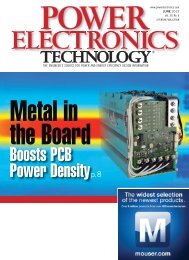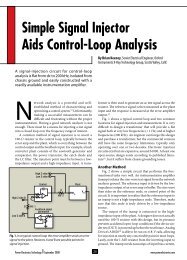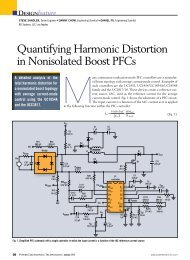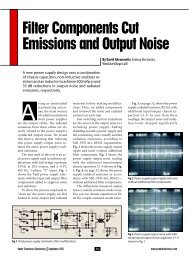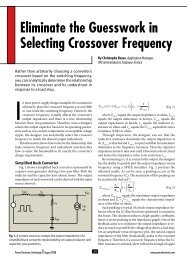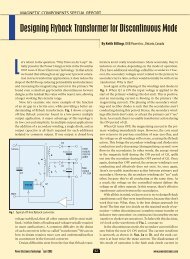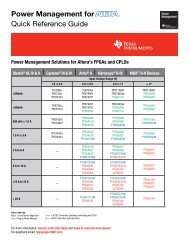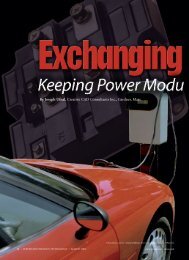Rudy SeveRnS - Power Electronics
Rudy SeveRnS - Power Electronics
Rudy SeveRnS - Power Electronics
You also want an ePaper? Increase the reach of your titles
YUMPU automatically turns print PDFs into web optimized ePapers that Google loves.
LiFETiME AchiEvEMEnT AwARd<br />
Chances to Innovate<br />
Nearly all of these power supplies for the spacecraft and<br />
GPS systems were SMPSs designed solely with discrete<br />
devices including bipolar junction transistors (BJTs or<br />
bipolars) for the switches. And all of the magnetic components<br />
were designed from scratch. These projects required<br />
innovation, which would require Severns to develop new<br />
circuit topologies and design techniques.<br />
For example, at ATC, Severns introduced a resonant<br />
power-supply design for space at a time when most space<br />
applications were using flyback converters. In this<br />
case, the resonant approach was motivated by the<br />
challenge of delivering high voltage at low power<br />
(milliwatts), but with very high efficiency. This<br />
work became the subject of his second paper.<br />
In this application, Severns says, “You had to<br />
supply 20 mW at 400 V from a 28-V spacecraft<br />
bus and you had to do it as efficiently as possible.<br />
That’s extremely difficult to do with hard switching.<br />
So I went with the resonant approach, which<br />
required some innovation.”<br />
At Hughes, his work with traveling wave<br />
tube amplifiers required him to invent circuits<br />
that could achieve high efficiency and very light<br />
weight. “That’s really where I started to invent<br />
new circuits and new topologies,” says Severns.<br />
The demand for very light weight together<br />
with small size would also be a motivating requirement<br />
at Magnavox. “That’s where I started doing very-highfrequency<br />
work,” says Severns.<br />
In the late ’70s, the standard for switchers was 20 kHz<br />
to 25 kHz. At Magnavox, Severns pushed the switching<br />
frequency beyond 100 kHz, even developing a tiny (for the<br />
time) SMPS running at 600 kHz. That work was the basis for<br />
two groundbreaking papers that he presented at <strong>Power</strong>Con<br />
and the <strong>Power</strong> <strong>Electronics</strong> Specialists Conference (PESC)<br />
in 1978 and eventually led to Severns’ appointment as an<br />
IEEE fellow.<br />
The <strong>Power</strong>Con paper, “Design of High-Efficiency Offline<br />
Converters Above 100 kHz” was one of the earliest to<br />
discuss the possibility of higher-frequency operation.<br />
“It was the first real proposal in a large power-supply<br />
forum that said, ‘Think about much higher switching<br />
frequencies.’” The paper was very popular, even receiving<br />
a best paper award, but it was also controversial. Severns<br />
recalls that Ron Birdsall, the organizer of the event, suggested<br />
that Severns write about something less “blue sky”<br />
and more practical for his next conference paper. But within<br />
two or three years, high-frequency switching wasn’t blue<br />
sky anymore.<br />
In addressing the <strong>Power</strong>Con audience, Severns took<br />
care to explain that high-frequency switching was an option,<br />
rather than a necessity in all cases. But this message<br />
was not heard.<br />
Severns recalls, “When I presented the paper, I was extremely<br />
careful to say, I am not telling you that you should<br />
operate at these frequencies. I am telling you that in certain<br />
situations you can and you may wish to operate at these<br />
frequencies. Of course, within months everyone was saying<br />
that I was advocating that we all shift to this frequency.”<br />
Severns notes that in later years, he went so far as to tell<br />
designers to decrease switching frequencies when higherfrequency<br />
switching wasn’t warranted.<br />
At the time Severns presented his paper, the use of SMPS<br />
technology was well established within the military and<br />
aerospace industries. However, it had not yet been accepted<br />
“<strong>Power</strong> electronics<br />
is alive and well.<br />
Everywhere I look,<br />
I see opportunities.”<br />
within the commercial industry. It’s frequently said that<br />
the arrival of the power MOSFET enabled the adoption<br />
of switch-mode technology by commercial power-supply<br />
merchants in the late ’70s and early ’80s.<br />
According to Severns, the power MOSFET also enabled<br />
the migration to the higher switching frequencies he was<br />
describing in his papers. “Almost immediately after I gave<br />
my paper, the power MOSFET came on the scene and<br />
designers didn’t have to go through the effort I did to make<br />
BJTs work at 150 or 200 kHz.”<br />
Nevertheless, the transition to higher frequencies did<br />
not happen overnight. It would take 10 years before the<br />
MOSFETs would become cheap enough that designers<br />
would use them en masse and be able to routinely design<br />
power supplies to operate at higher frequencies, according<br />
to Severns.<br />
Adventures in Semiconductors<br />
When Severns gave his <strong>Power</strong>Con paper in San Francisco,<br />
the sales manager from Intersil was in the audience.<br />
“With some later arm twisting, he dragged me up to go<br />
to work for Intersil, because they were simultaneously<br />
[along with Siliconix, Hewlett-Packard and International<br />
Rectifier] coming out with power MOSFETs.<br />
“Intersil lured me away, but I was easy to lure because it<br />
was really different. Developing hardware is one world. The<br />
semiconductor industry is another world,” says Severns.<br />
At the time he started working at Intersil as a field<br />
applications engineer (FAE), the only design he had com-<br />
<strong>Power</strong> <strong>Electronics</strong> Technology September 2008 42<br />
www.powerelectronics.com




